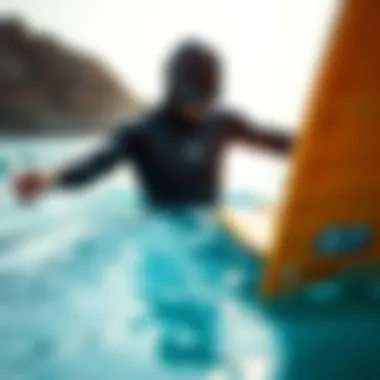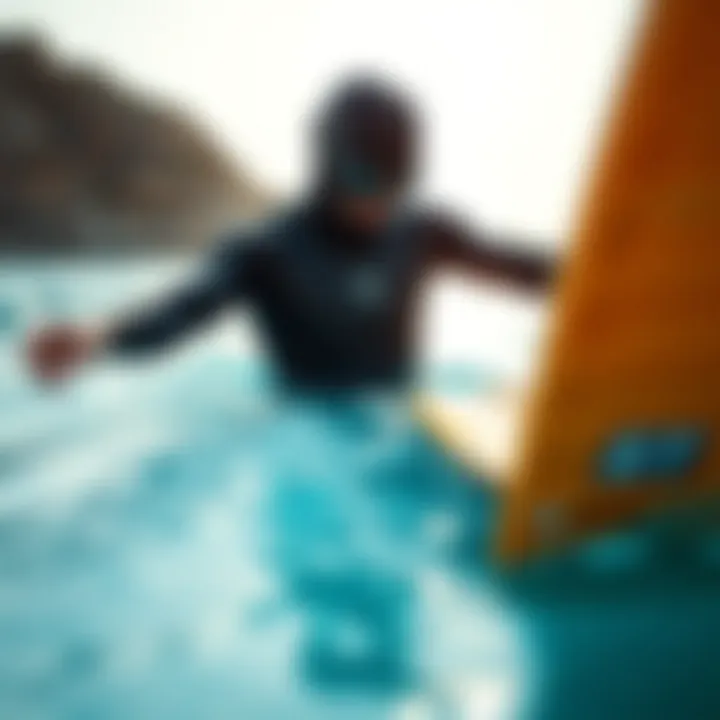Top 4 3 Wetsuits for Maximum Watersport Performance


Intro
Choosing a wetsuit isn’t just about picking a piece of gear off the rack; it’s about enhancing your performance in the water, whether you are surfing, diving, or paddle boarding. The right wetsuit, particularly a 4 3 model, not only provides warmth but also flexibility and comfort, making it essential for aquatic activities in cooler temperatures. This guide will take a closer look at the best 4 3 wetsuits available. Let’s strip away the fluff and get down to what really matters: features, materials, and how to choose the right wetsuit for your specific needs.
Tips and Techniques
Beginner Tips for Watersports
If you’re just dipping your toes into the world of watersports, understanding certain fundamentals can set you up for success. Here are a few pointers to consider:
- Fit is Key: Wetsuits should feel snug without being restrictive. When you try one on, you shouldn’t feel like a sausage in a casing. A good fit allows for insulation and flexibility.
- Invest in Quality: You might be tempted to grab a cheap option, but remember, you get what you pay for. The right wetsuit can last for years if cared for properly.
- Know Your Environment: Different conditions call for different wetsuits. Take into account the water temperature and activity type when choosing your gear.
Advanced Techniques for Mastery
If you've already dabbled in some watersports and you're looking to level up, understanding how to optimize your wetsuit experience can be a game changer:
- Layering: In colder waters, consider layering your wetsuit with thermal vests or rash guards. This can help retain more heat without adding extra bulk.
- Wetsuit Care: Proper maintenance will stretch the lifespan of your suit. Rinse it with fresh water after use, dry it inside out, and avoid exposing it to direct sunlight for extended periods.
- Utilize Accessories: Don't overlook accessories such as gloves, boots, and hoods that can complement your wetsuit, further enhancing your comfort and performance in colder conditions.
"Selecting the right wetsuit is not just about warmth; it’s also about performance and comfort in the water."
Safety and Gear
Essential Safety Practices
Participating in any watersport demands attention to safety. Here’s a checklist to keep in mind:
- Buddy System: Always go with a partner, particularly if you’re venturing into unfamiliar waters.
- Know Your Limits: If the conditions look nasty, it’s better to sit it out.
- Wear a Leash: For surfers, a leash keeps your board within reach, reducing the risk of injury for you and others.
Gear Reviews and Recommendations
When it comes to top-notch 4 3 wetsuits, a few brands regularly pop up in discussions:
- O'Neill Psycho Tec: Known for fantastic flexibility and warmth.
- Rip Curl Flashbomb: Combines high-performance materials with an efficient drying system.
- Xcel Drylock: Highly rated for its comfort and a snug fit.
Whether you’re a novice or an expert, selecting the ideal wetsuit can dramatically impact your watersport experience. As you dive deeper into this guide, consider your personal preferences, environment, and specific activities to make an informed decision.
Prelims to Wetsuits
Wetsuits are more than just fancy diving gear; they are essential tools for anyone serious about water sports. When the temperatures dip or the waves kick up, a well-fitted wetsuit can make all the difference in performance and comfort. In this article, we will explore what wetsuits are, their vital functions in regulating body temperature, and the importance of selecting the right thickness.
What is a Wetsuit?
A wetsuit is a specialized garment made primarily from neoprene, designed to provide insulation and protect the body in cold water. The suit works by trapping a thin layer of water between the suit and the body. As the body warms the water, it creates a thermal barrier that keeps the core temperature steady.
Wetsuits come in various styles and thicknesses, including full suits, shorties, and even hybrids, depending on the needs of the user. Each design aims to offer flexibility and warmth while allowing for a good range of movement. Whether you're surfing, diving, or kayaking, a wetsuit is a necessary layer of protection against chilly waters.
The Importance of Thickness
Wetsuits are available in different thicknesses, typically measured in millimeters. A 4/3 wetsuit, for example, denotes 4mm thickness in the torso and 3mm in the extremities. This variation is crucial because different body parts lose heat at different rates.
Choosing a wetsuit with the right thickness is vital for optimal performance. For instance, a thicker suit provides better insulation, making it more suitable for cooler waters. Conversely, it might feel restrictively warm in milder conditions. On the other hand, a thinner wetsuit may offer a greater range of motion, enhancing performance in activities like surfing but may not provide enough warmth in colder waters. Thus, selecting the right wetsuit based on thickness not just enhances comfort but also contributes significantly to performance.
"A wetsuit is not just a piece of clothing, it's a second skin that bridges the gap between you and the ocean's elements."
Understanding these foundational aspects of wetsuits lays the groundwork for exploring the specific features and functions of 4/3 wetsuits, which will be covered in later sections.


Overview of Wetsuits
When it comes to water sports, a good wetsuit can be the difference between a comfortable, enjoyable day on the waves and a freezing, miserable experience. The 4 3 wetsuit is an optimal choice for many aquatic activities, especially in temperate climates where the water temperature varies. Understanding these suits, their make-up, and how they fit into the broader context of watersport gear is essential for anyone looking to enhance their performance and enjoyment.
Defining Wetsuits
The term 4 3 wetsuit refers to the thickness of the neoprene used in its construction: four millimeters in the torso and three millimeters in the limbs. This combination offers a solid balance of insulation and flexibility—crucial factors when you're navigating chilly waters. The thicker core keeps you warm while the thinner sleeves and legs allow for freedom of movement, enabling you to paddle, surf, or dive without feeling restricted.
When you’re knee-deep in the ocean, the right suit can keep you shivering less and paddling more. Most of these wetsuits are designed to stretch, providing that snug fit without being too tight. The catchphrase here? "Just right, not too cold, not too tight."
Common Use Cases
The versatility of 4 3 wetsuits means they serve various purposes:
- Surfing: Ideal for surfers who crave comfort and flexibility in unpredictable ocean conditions.
- Diving: Provides sufficient warmth while allowing divers to maintain agility underwater.
- Kiteboarding: Offers the right blend of insulation and movement, crucial for handling the elements.
- Paddleboarding: Great for both casual paddling and more rigorous activities, keeping you comfortable across longer durations.
In temperate zones, these suits are commonly used in spring and fall when the water is cool but not frigid. They effectively bridge the gap between thicker suits needed in winter and thinner suits used in summer.
By recognizing the context in which 4 3 wetsuits excel, users—from novices to seasoned professionals—can make informed choices tailored to their specific water activities. As you navigate through your watersport endeavors, knowing how to select the right wetsuit can undoubtedly optimize your performance and overall experience.
Material Composition
Understanding the composition of a wetsuit is crucial, particularly when selecting a 4 3 wetsuit designed for optimal performance in various aquatic environments. The materials used not only influence the suit's warmth and flexibility but also affect durability and comfort levels. As athletes, coaches, and enthusiasts explore their options, recognizing the significance of a wetsuit's material composition can enhance their experience and ensure their safety during water activities.
Neoprene: The Standard
Neoprene has long stood as the go-to material for wetsuits, and for good reason. This synthetic rubber is renowned for its insulation properties. When submerged in cold water, neoprene traps a layer of water close to the skin, which the body gradually warms up, creating a thermal barrier that helps maintain body temperature. This makes it particularly effective in colder conditions, ensuring that surfers, divers, and other water sports aficionados remain comfortable and focused.
However, not all neoprene is created equal. Some variations boast superior stretch and flexibility, crucial for allowing freedom of movement during physical activities. For example, premium-quality neoprene options can offer up to 200% stretch, which can make a world of difference when paddling out or diving below the waves. You might often hear that a good wetsuit should feel "like a second skin," and that sentiment rings true with high-grade neoprene.
Furthermore, with innovations in design, brands now incorporate different thicknesses of neoprene in various parts of the wetsuit. Thicker panels might be found around the torso to aid in insulation, while thinner sections may be placed around the shoulders and knees where flexibility is paramount. This attention to detail showcases why it's crucial to look beyond just the material name and consider its application and suitability for your specific activity.
Eco-Friendly Alternatives
While neoprene remains the prevailing choice, growing awareness about environmental impacts has prompted manufacturers to explore eco-friendly alternatives. Brands are now experimenting with materials such as natural rubber, which is derived from trees rather than petroleum products. This can be particularly appealing for those who are environmentally conscious and wish to reduce their carbon footprint while enjoying aquatic adventures.
Additionally, limestone-based neoprene is gaining traction as a more sustainable option. This material tends to have fewer harmful chemicals in its production process and typically offers similar thermal properties as traditional neoprene. As outdoor enthusiasts demand more sustainable options, these innovations represent a shift in the industry towards more responsible practices.
Ultimately, selecting a wetsuit made from environmentally friendly materials can bring peace of mind while also ensuring quality performance. Whether it's cotton-blended fabrics or specialized recycled materials, considering these options can lead to better choices for both the individual and the planet.
"Investing in a wetsuit made with sustainable materials can enhance your performance while aligning with personal values aimed at preserving our waters for future generations."
Key Features of Wetsuits
Understanding the key features of 4 3 wetsuits is crucial when it comes to ensuring peak performance during water activities. Each feature serves a distinct purpose, contributing to the wearer's comfort, mobility, and overall experience in aquatic environments. A good wetsuit doesn’t just keep you warm; it also allows for fluid movement, effectively protects against the elements, and enhances your ability to perform tasks efficiently in the water.
Insulation and Temperature Regulation
The primary function of a 4 3 wetsuit is to provide insulation in cold water conditions. The numbers "4 3" refer to the thickness of the neoprene material—four millimeters in the core areas and three millimeters in areas that require flexibility, such as the arms and legs. This thickness plays a pivotal role in temperature regulation.
Wetsuits trap a thin layer of water between the suit and your skin, which is heated by your body. This trapped water acts as an insulating barrier, keeping you warm. In contrast, a poorly insulated wetsuit can lead to rapid heat loss, making you feel cold and uncomfortable. Moreover, modern wetsuit designs incorporate advanced features like thermal linings and strategically placed panels to optimize heat retention without sacrificing flexibility.
"The right insulation can mean the difference between a good day out and a shivering session in the surf."
Flexibility and Range of Motion
Flexibility is another paramount aspect of a 4 3 wetsuit. This flexibility allows athletes to paddle, dive, and move with ease. A wetsuit that is too tight can hinder performance significantly. The best models clear this hurdle by integrating super stretch neoprene in areas that require more mobility.


Think of it this way: if you’ve got a wetsuit that feels like a straitjacket, you’ll likely struggle with basic movements. This is especially important for surfers and divers who rely on quick, dynamic physical actions. By choosing a wetsuit with an optimal balance between thickness and stretch, you’ll ensure that your movements remain fluid and natural.
Seams and Construction Techniques
The way a wetsuit is constructed is just as vital as its outer material. Seams play a considerable role in both waterproofing and durability. There are various seam types to consider, including flatlock seams, blind stitched seams, and sealed seams. Flatlock seams are durable but not fully waterproof, while blind stitched seams offer better insulation by minimizing water entry.
Sealed seams represent the gold standard in wetsuit construction. They are designed to keep water out entirely, which is particularly beneficial in colder waters. When selecting a wetsuit, understanding these construction techniques not only gives insight into its longevity but also its performance capabilities.
Every seam and stitch contributes to the overall ability of your wetsuit to perform in diverse water conditions.
In summary, focusing on insulation and temperature regulation, flexibility and range of motion, and seams and construction techniques can empower both seasoned athletes and newcomers to make informed choices. An understanding of these elements can significantly enhance your aquatic adventures, helping you select a wetsuit that aligns precisely with your needs.
Selecting the Right Wetsuit
Choosing the appropriate 4 3 wetsuit is a cornerstone of any successful watersport experience. The right fit not only enhances performance but also ensures comfort and safety in the water. With the variety of options available on the market, it's essential to understand the nuances involved in selecting a wetsuit that aligns with personal preferences and environmental conditions. Moreover, understanding the suitability of a wetsuit can mean the difference between conquering the waves and battling discomfort.
Fit and Comfort
The fit of a wetsuit is paramount. An ill-fitting wetsuit can lead to chafing, restrict movement, or create unnecessary drag in the water. Conversely, a snug wetsuit enhances body heat retention and promotes efficient hydrodynamics. As a rule of thumb, one should aim for a second-skin feel without any gaps. This approach ensures that water doesn't seep into the suit, making it crucial for maintaining warmth during extended exposure to chilly water.
Comfort goes beyond just fit; it encompasses mobility and ease of putting on and taking off the wetsuit. For instance, choosing a wetsuit with strategically placed seams and stretch panels can significantly improve mobility. Likewise, some wetsuits come with features like back zippers or front zippers—this makes the putting on process less cumbersome, especially for solo adventurers.
Choosing the Correct Size
Selecting the right size is integral to enjoying a successful outing. To ensure an optimal fit, measuring certain body dimensions is vital. Common measurements include chest, waist, hip, and inseam. Most brands provide size charts that correlate these measurements to specific sizes. Paying attention to these details can prevent the pitfalls associated with sizes that are too small or too large.
Many athletes have found that trying the wetsuit on with appropriate undergarments is essential for accurate sizing. Additionally, if you're between sizes, it might be worthwhile to opt for the smaller size for a performance-focused fit, or go larger if you prioritize comfort and ease of use.
Assessing Suit Features
Not all wetsuits are created equal; therefore, assessing specific features that cater to individual needs is crucial. One noteworthy aspect is the construction of the suit. Wetsuits can have various seam technologies, such as flatlock, blind-stitched, or taped seams. Flatlock seams are ideal for warmer waters as they allow for breathability, while blind-stitched and taped seams offer superior insulation for colder environments.
Beyond seams, the material composition plays a role in the overall performance of a wetsuit. Lighter, more flexible materials provide a range of motion, while thicker neoprene offers better insulation, making it essential to strike a balance based on the conditions you plan to dive into.
"The best wetsuit is the one you forget you’re wearing. Comfort and fit are primary requirements to optimize your performance."
Another important feature to explore is the entry system. Some suits have back zippers, while others come as front-zip or even zip-free. Each design caters to different preferences and may impact the ease of getting suited up.
Comparative Analysis of Top Brands
When diving into the world of 4 3 wetsuits, a comparative analysis of top brands becomes essential. Each brand brings its own flavor, strengths, and weaknesses to the table, which can noticeably affect performance and comfort.
Understanding the nuances between these brands helps consumers make informed choices. Whether you're a seasoned athlete or a weekend warrior, a proper understanding can save you time and money while ensuring you select a wetsuit tailored to your specific needs. The goal here is to provide clarity in an often-overwhelming market.
In order to assist you in weighing your options, we’ve examined three prominent brands in the 4 3 wetsuit space: XCEL, O’Neill, and Rip Curl. Each brand showcases unique offerings and competitive features worth exploring.
Brand A Overview
XCEL has long been a significant player in the wetsuit market, known for its innovation and dedication to quality. Their 4 3 wetsuits are meticulously crafted, combining high-quality neoprene with advanced technologies. One of their standout features is the Thermo Dry Celliant lining, which claims to enhance warmth and energy efficiency.
Moreover, the seals on XCEL suits are engineered with precision, minimizing water entry and keeping you warmer for longer. That’s a game changer in colder waters. Additionally, their focus on flexibility and range of motion makes these wetsuits ideal for athletes who require agility during water activities.
Brand B Overview
O’Neill, another big name, takes a slightly different approach by emphasizing both performance and style. Their 4 3 wetsuits are not only functional but also trendy, featuring a range of colors and designs that appeal to a broader audience. With their unique FluidFlex technology, O’Neill aims to cater to snugness without compromising mobility.


One potential drawback is that some users have reported that their suits run slightly smaller than expected, which calls for careful size selection. However, O’Neill remains a popular choice, thanks to their quality build and affordability, especially for those who regularly hit the waves or enjoy water sports in temperate climates.
Brand Overview
Rip Curl is celebrated for its commitment to providing top-notch wetsuits designed specifically for surfers. Their 4 3 models are packed with features such as the E5 neoprene blend, which provides warmth and unmatched stretch. This makes them an appealing option for professionals or serious enthusiasts who don’t want to be constrained.
Rip Curl has made strides in ensuring their suits are durable, even under the most rigorous conditions. Their research and development teams regularly field-test products, meaning that the wetsuits are continually refined based on athlete feedback and performance metrics. The trade-off? They can be on the pricier side, but many users believe the investment is warranted given the quality.
Performance in Diverse Conditions
Selecting the proper wetsuit transcends mere style or aesthetics; it directly influences an athlete's performance during their aquatic escapades. The ability of a 4 3 wetsuit to adapt to various environmental conditions is pivotal, providing insulation from the cold and flexibility for a range of movements. Particularly for competitive swimmers, surfers, or divers, understanding how their suit fares in different climates can determine their comfort and overall success in the water. Each condition presents its unique challenges, and today's athletes must be armed with knowledge to make the best choice.
Cold Water Performance
When it comes to chilly waters, a 4 3 wetsuit can be your best friend. This type of wetsuit offers a thickness of 4mm in the torso and 3mm in the extremities, striking a balance between insulation and flexibility. The importance of keeping body temperature regulated in these conditions cannot be overstated.
- Insulation Mechanics: Cold water can sap energy quickly, leading to fatigue. The thick neoprene material traps a thin layer of water against the skin, which warms up from body heat, thus keeping the core temperature stable.
- Flexibility Considerations: While insulation is crucial, flexibility shouldn’t take a back seat. Choosing a wetsuit with good seam construction and flexibility will allow smooth strokes and movements. Brands like O’Neill and Rip Curl have engineered their suits to optimize this balance.
- Layering Strategies: Additional layers such as thermal rash guards can enhance warmth, while still allowing freedom in movement. Consider using thermal accessories like hoods and booties if facing really frigid waters, especially during winter surfing.
"Staying warm and mobile in cold waters isn't a luxury—it's a necessity for peak performance."
Warm Water Considerations
Conversely, navigating warm waters without a proper wetsuit can lead to excessive sun exposure and a dangerous rise in body temperature. A 4 3 wetsuit during warmer conditions helps in more ways than one.
- UV Protection: While the 4mm thickness might seem excessive, the suit provides vital protection from harmful UV rays. Long exposure can result in sunburn or even skin damage.
- Comfort in Heat: It's a common misconception that thicker wetsuits are only for cold waters. A well-designed 4 3 wetsuit with strategic venting is remarkably effective in dissipating heat, while still providing lightweight comfort. Suits featuring ventilated neoprene can work wonders.
- Hydration and Performance: Wearing a wetsuit can also encourage more efficient hydration practices as it gives a sense of temperature control, leading to higher endurance levels. Athletes can focus more on performance without being distracted by the elements.
In summary, performance in varied water conditions hinges on the quality and type of wetsuit chosen. Athletes must assess their environment wisely, weighing insulation against flexibility and comfort against protection. With research and an understanding of these aspects, selecting the optimal 4 3 wetsuit becomes a strategic advantage rather than a daunting task.
Maintenance and Care
When it comes to 4 3 wetsuits, maintenance and care are the lifelines that can significantly prolong their usability and performance. Just as an athlete trains to stay in peak condition, your wetsuit requires attentive care to withstand the rigors of the elements and aquatic adventures. Neglecting this aspect can lead to wear and tear, decreased insulation, and even discomfort in the water. By understanding proper maintenance techniques, enthusiasts can greatly enhance their wetsuit's longevity.
Proper Cleaning Techniques
One of the foremost steps in maintaining your wetsuit is ensuring it's cleaned correctly after every usage. Here are some valuable points to consider:
- Rinse with Fresh Water: After each session, rinse your wetsuit thoroughly with fresh, cold water. Salt and chlorine can degrade the neoprene material if left unchecked.
- Avoid Harsh Detergents: Use a mild soap specially formulated for wetsuits. Strong chemicals can strip away essential oils, which help keep the material supple. A good tip is to look for biodegradable options to minimize environmental impact.
- Turn Inside Out: When cleaning, it’s beneficial to turn your wetsuit inside out. This exposes the area that has been closest to your body, getting rid of any odors or sweat that might linger.
- Dry Naturally: After cleaning, lay your wetsuit flat away from direct sunlight instead of hanging it up. This preserves its shape and prevents unnecessary stretching. Always allow it to dry completely before storage—no one wants a damp squatter in their closet!
A well-cared-for wetsuit is not just about longevity; it’s also about your comfort in the waves.
Storage Recommendations
Once cleaned, proper wetsuit storage is equally essential for maintaining its integrity. Here are some considerations to follow:
- Find a Cool, Dry Place: Store your wetsuit in a cool, dry area away from heat sources, such as radiators and direct sunlight. Extreme temperatures can distort its shape and degrade the material.
- Avoid Folding: Rather than folding it, hang your wetsuit on a wide hangar to prevent creasing and maintain its original form. Some enthusiasts even use special wetsuit hangers to distribute weight evenly.
- Use a Storage Bag: Placing your wetsuit in a dedicated storage bag can prevent dirt and outside elements from spoiling it. Ensure the bag is breathable to avoid trapping moisture.
- Inspect Before Use: Each time you pull it out for an adventure, take a moment to inspect for any visible signs of damage or degradation like tears or worn-down seams. Early detection can save you a lot of headaches later.
By integrating these maintenance and storage practices into your routine, you ensure that your 4 3 wetsuit remains not just an outfit, but a steadfast companion in your aquatic quests. Regular care translates to superior performance and comfort, allowing you to truly enjoy every wave.
Epilogue
The conclusion of this article serves not just as a wrap-up, but as the final avenue to reflect on the vital elements that were discussed earlier. Selecting a 4 3 wetsuit, for instance, demands comprehension of multiple factors, including materials, fit, and intended use, all of which contribute to achieving optimal performance in water sports. The information presented throughout this article serves as a guide for both novice and seasoned enthusiasts, ensuring that they do not just purchase any wetsuit, but one that truly aligns with their unique needs.
When considering your options, remember that the right wetsuit can make or break your experience out on the waves. A well-fitted wetsuit can offer not just insulation, but also the mobility necessary for activities like surfing or diving. Conversely, a poorly chosen wetsuit can lead to discomfort, limiting your movements and thus affecting performance negatively.
Key Benefits of a Thoughtful Choice
- Enhanced Performance: Proper insulation aids performance by maintaining body temperature regardless of external conditions.
- Increased Comfort: A suit that fits well reduces chafing and allows freedom of movement.
- Longevity: Making a wise choice from the start can prolong the lifespan of your wetsuit, ultimately saving you money.
This article aimed to equip you with insights on the various aspects of selecting a 4 3 wetsuit. As we reach the conclusion, the emphasis is on being mindful about your choice, considering both personal preferences and environmental factors.
“A good wetsuit is more than protection from cold water; it’s an extension of yourself in the water.”
Whether you're planning a surf trip, diving expedition, or just spending time in chilly waters, the lessons here can help you approach purchasing a wetsuit with confidence. Don't hesitate to assess the features highlighted previously, as they are essential in guiding your decision-making process. The goal is to wear a garment that is not just adequate, but exceptional for the activities you love the most. With a well-chosen 4 3 wetsuit, explore and embrace the aquatic world that awaits you.















